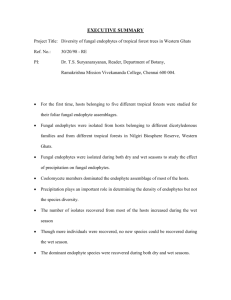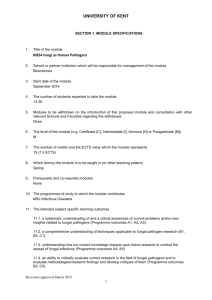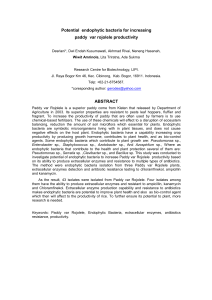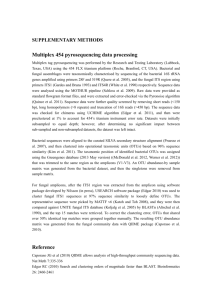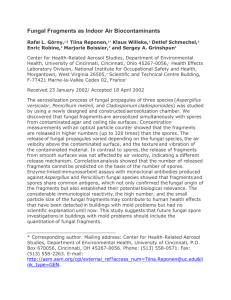Endophytic mycobiota of leaves and roots of the grass Holcus lanatus
advertisement
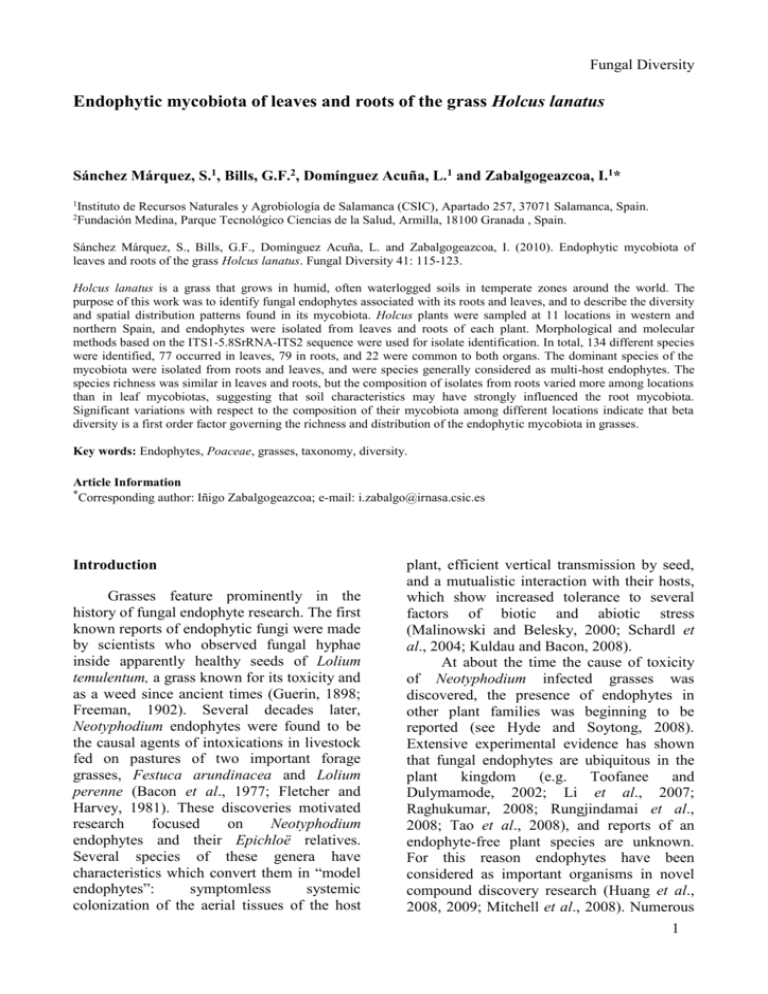
Fungal Diversity Endophytic mycobiota of leaves and roots of the grass Holcus lanatus Sánchez Márquez, S.1, Bills, G.F.2, Domínguez Acuña, L.1 and Zabalgogeazcoa, I.1* 1 Instituto de Recursos Naturales y Agrobiología de Salamanca (CSIC), Apartado 257, 37071 Salamanca, Spain. Fundación Medina, Parque Tecnológico Ciencias de la Salud, Armilla, 18100 Granada , Spain. 2 Sánchez Márquez, S., Bills, G.F., Domínguez Acuña, L. and Zabalgogeazcoa, I. (2010). Endophytic mycobiota of leaves and roots of the grass Holcus lanatus. Fungal Diversity 41: 115-123. Holcus lanatus is a grass that grows in humid, often waterlogged soils in temperate zones around the world. The purpose of this work was to identify fungal endophytes associated with its roots and leaves, and to describe the diversity and spatial distribution patterns found in its mycobiota. Holcus plants were sampled at 11 locations in western and northern Spain, and endophytes were isolated from leaves and roots of each plant. Morphological and molecular methods based on the ITS1-5.8SrRNA-ITS2 sequence were used for isolate identification. In total, 134 different species were identified, 77 occurred in leaves, 79 in roots, and 22 were common to both organs. The dominant species of the mycobiota were isolated from roots and leaves, and were species generally considered as multi-host endophytes. The species richness was similar in leaves and roots, but the composition of isolates from roots varied more among locations than in leaf mycobiotas, suggesting that soil characteristics may have strongly influenced the root mycobiota. Significant variations with respect to the composition of their mycobiota among different locations indicate that beta diversity is a first order factor governing the richness and distribution of the endophytic mycobiota in grasses. Key words: Endophytes, Poaceae, grasses, taxonomy, diversity. Article Information *Corresponding author: Iñigo Zabalgogeazcoa; e-mail: i.zabalgo@irnasa.csic.es Introduction Grasses feature prominently in the history of fungal endophyte research. The first known reports of endophytic fungi were made by scientists who observed fungal hyphae inside apparently healthy seeds of Lolium temulentum, a grass known for its toxicity and as a weed since ancient times (Guerin, 1898; Freeman, 1902). Several decades later, Neotyphodium endophytes were found to be the causal agents of intoxications in livestock fed on pastures of two important forage grasses, Festuca arundinacea and Lolium perenne (Bacon et al., 1977; Fletcher and Harvey, 1981). These discoveries motivated research focused on Neotyphodium endophytes and their Epichloë relatives. Several species of these genera have characteristics which convert them in “model endophytes”: symptomless systemic colonization of the aerial tissues of the host plant, efficient vertical transmission by seed, and a mutualistic interaction with their hosts, which show increased tolerance to several factors of biotic and abiotic stress (Malinowski and Belesky, 2000; Schardl et al., 2004; Kuldau and Bacon, 2008). At about the time the cause of toxicity of Neotyphodium infected grasses was discovered, the presence of endophytes in other plant families was beginning to be reported (see Hyde and Soytong, 2008). Extensive experimental evidence has shown that fungal endophytes are ubiquitous in the plant kingdom (e.g. Toofanee and Dulymamode, 2002; Li et al., 2007; Raghukumar, 2008; Rungjindamai et al., 2008; Tao et al., 2008), and reports of an endophyte-free plant species are unknown. For this reason endophytes have been considered as important organisms in novel compound discovery research (Huang et al., 2008, 2009; Mitchell et al., 2008). Numerous 1 Fungal Diversity endophytic species have been found to be associated with each plant species, and unlike Epichloë and Neotyphodium endophytes, most endophytic species appear to be non-systemic and not transmitted by seed (Stone et al., 2004; Schulz and Boyle, 2005; Arnold, 2007; Sieber, 2007). Neotyphodium and Epichloë endophytes have possibly received more attention than any other endophytic genera, but the knowledge of non-systemic endophytic taxa associated with grasses is more limited, especially in non-domesticated species. Previously we had surveyed and studied some characteristics of the non-systemic endophytic mycobiota associated with grasses adapted to different habitats like semiarid grasslands (Dactylis glomerata, Sánchez Márquez et al., 2007) and coastal dunes (Ammophila arenaria and Elymus factus; Sánchez Márquez et al., 2008) in Spain. The purpose of this work was to identify and compare the culturable endophytic mycobiota associated to roots and leaves of Holcus lanatus, a grass which grows in humid, often waterlogged soils (Hubbard, 1992), and to study the patterns variation in the species composition of the Holcus mycobiota across different locations. Materials and methods Plant material All the plants sampled grew in damp soils, near river and stream banks. Plants were obtained from 11 different locations in Spain: eight in the province of Cáceres, two in Zamora, and one in Oviedo. Cáceres and Zamora are in western Spain, where the climate is continental, while Oviedo is in the north Atlantic coast and has a milder oceanic climate (Table 1). At each location seven plants were dug out from the field leaving a distance of at least 10 m between each pair of plants. Plants were transported to the laboratory, where they were processed for endophyte isolation in less than 24 hours. Endophyte isolation Several asymptomatic leaves of each plant were transversely cut in fragments of approximately 5 mm of length. The surface of the fragments was disinfected by means of a 1 minute treatment with a solution of aqueous 0.001% Tween-80, followed by a 10 minute treatment with a solution of 20% household bleach (1% active chlorine). After rinsing in sterile water, approximately 15 fragments were placed on each of 2 plates of potato dextrose agar (PDA) containing 200 mg/L of chloramphenicol. Root fragments of each plant were surface-disinfected with a 5 minute rinse in 96% ethanol, followed by treatment with a 1% active chlorine solution for 15 minutes, 2 minutes in ethanol, and a final rinse in sterile water (Bills, 1996). The effectiveness of the surface sterilization was controlled by making imprints of disinfected leaf fragments on PDA plates (Schulz et al., 1998). Endophyte identification To induce sporulation in isolates which only grew vegetatively in PDA, isolates were plated in water agar containing autoclaved leaf pieces of H. lanatus (WAL). Sporeproducing isolates were identified by their morphological characters, but in addition, specimens of most isolates were also identified with the aid of the nucleotide sequence of the ITS1-5.8SrRNA-ITS2 region. Fungal DNA and amplicons of this region were obtained as described by Sánchez Márquez et al. (2007), and both strands of the ITS amplicons were sequenced. All sequences were aligned (Thompson et al., 1997), and those being more than 97% identical were arbitrarily considered to be conspecific. The selected sequences were used to interrogate the EMBL/GenBank fungal nucleotide database to find the closest matches. For this purpose the FASTA algorithm was used, and the criteria used to adscribe Holcus endophyte sequences to a given fungal taxon present in the database were the same used by Sánchez Márquez et al. (2007). Isolates with sequences being less than 95% similar to their closest database match were considered as unidentified. All the fungal sequences obtained were deposited in the EMBL/GenBank database. 2 Fungal Diversity Analysis of diversity in endophytic assemblages of leaves and roots Differences between leaves and roots in the average number of isolates, species, and Shannon’s diversity index (H’) per location were tested with a Student’s t test, with =0.05. Species accumulation curves for leaves and roots were plotted with data from all species obtained from each organ, and with the subset of plural species (represented by more than two isolates) of each organ (Colwell, 2005). Several incidence-based estimators of the total number of species (ICE, Chao 2, Bootstrap, and MichaelisMenten) were calculated from the combined data from foliar and root assemblages (Magurran, 2004). The similarity in the species composition of root (JR) or leaf (JL) assemblages among all possible pairs of locations was estimated using Jaccard´s coefficient of similarity (Magurran, 2004). The similarity between the leaf and root assemblages of each location (JLR) was also calculated to determine if leaf and root mycobiota from the same location were similar. Mean similarities between leaf and root assemblages were compared using a Student’s t test with = 0.05. Beta diversity, or the amount of change in species composition between locations, was estimated as the average proportion of species in each location which are not found at other locations. This number was calculated by dividing the average number of shared species per location by the average number of species per location, and subtracting this number from one. This measure has values ranging from 0 to 1; a value of 1 indicates that no species are shared among locations and variation among locations is large, on the other hand, a value of 0 indicates that all species from one location occur in all other locations, and therefore, the spatial variation is low. To determine if the amount of variation in the species composition of different endophytic assemblages was linked to the distance among locations, the correlation between Jaccard’s similarity index for each possible pair of locations and their geographic distance was calculated. Results Endophyte isolation and identification The surface disinfection treatments used for leaf and root samples were efficient eliminating epiphytic fungi because leaf or root imprints yielded no fungi or yeasts. Endophytes were isolated from 75 of the 77 plants analyzed. After retaining only one morphologically similar isolate (morphospecies – sensu Lacap et al., 2003) from each plant, 199 isolates from leaves and 149 from roots were obtained and processed for further identification (Table 1). Complete sequences of the ITS1-5.8SrRNA-ITS2 region of 105 leaf and 109 root representative isolates were obtained. Using sequence data and morphological characters, 134 different species of fungal endophytes were identified, 77 were isolated from leaves (Table 2), and 79 from roots (Table 3); 22 species were common to both plant organs. The morphological and molecular identification obtained for all the isolates which could be identified by both methods coincided in all cases. Although some species which were sterile in PDA sporulated on WAL plates, 46 species remained sterile, and their identifications were approximated exclusively on molecular characters. With the aid of their nucleotide sequences, four sterile strains could be identified to species rank; the remaining 42 sterile strains were considered “unknown” because their sequences were less than 95% similar to any identified accession from the EMBL/Genbank fungus database. However, a dendrogram constructed with all sequence data clustered all these unknown strains with other ascomycetes. Except for eleven basidiomycetes and two zygomycetes, all other species belonged to the Ascomycota. Diversity and abundance distribution of endophyte assemblages On average, 12 different species were observed at each location (Table 1). Isolate 3 Fungal Diversity richness was very unequally distributed among endophytic species (Figure 1). In leaves 11 dominant species accounted for 50% of all isolates (Alternaria sp., Arthrinium sp., Aspergillus tubingensis, Aureobasidium pullulans, Chaetomium globosum, Cladosporium sp., Curvularia inaequalis, Drechslera sp., Epicoccum sp., Nigrospora oryzae, and Penicillium sp.). In roots isolate richness was more dispersed among taxa; 16 taxa accumulated 50% of all root isolates (Acremonium sp., Alternaria sp., Aspergillus tubingensis, Chaetomium funicola, Cladosporium sp., Curvularia inaequalis, Drechslera sp. A, Epicoccum sp., Fusarium oxysporum, Fusarium tricinctum, Gaeumannomyces cylindrosporus, Leptodontidium sp., Microdochium sp., Penicillium sp., Periconia macrospinosa, and Podospora sp.). In contrast with these dominant species, about two thirds of the leaf (70.1%) and root (68.4%) species were unique, represented by a single isolate. Species accumulation curves for the endophytic mycobiota from leaves and roots were non-asymptotic (Figure 2). In contrast, curves approaching asymptotic increase were obtained when only plural species consisting of two or more isolates were considered. Differences between organs and locations Although more isolates were obtained from leaves than from roots, the difference between the average number of isolates obtained from each organ per location was not statistically significant (Table 1). The average number of species occurring at each location was very similar for leaf and root mycobiotas (Table 1), and the same occurred for the H’ index (Table 1). These results indicate that leaves and roots were not different with respect to the number of isolates or species which can be found in them. Jaccard’s index was used to estimate the amount of similarity among leaf or root endophytic assemblages at each possible pair of locations, as well as the similarity between leaf and root assemblages at each location. Across locations, the mean similarity per pair of leaf mycobiotas had a value of J L = 0.15, while for roots the similarity was smaller JR= 0.08. The difference among these means was statistically significant (t=-5.31289; p<0.01), indicating that leaf mycobiotas tended to be more similar in species composition than root mycobiotas. The average similarity between the leaf and root assemblages from each location was JLR = 0.09. Because the similarity of leaf assemblages is greater than that observed among leaves and roots of the same location, this result suggested that the fungi present in leaves in plants of one location did not tend to be present in the roots of the same plants. Species variation among locations was important; although in total 134 different species were identified, an average of only 12.2 species were identified at each location. In leaf assemblages the average number of species shared by any pair of locations was 3.13, and in root assemblages this number was 1.73. Dividing these numbers by the mean number of species found at each location, it was possible to estimate the proportion of species found at each location which were not present at others. This estimate was greater for root (0.85) than for leaf mycobiotas (0.75), and suggested that beta diversity was greater for root than for leaf endophyte assemblages. Several dominant taxa of leaves and roots were also the most cosmopolitan. The ten most widespread taxa were Cladosporium sp. (11 locations), Alternaria sp. (8), Aspergillus tubingensis (8), Penicillium sp. (8), Podospora sp. (8), Curvularia inaequalis (7), Aureobasidium pululans (6), Epicoccum sp. (6), Acremonium sp. (5) and Drechslera sp. A (5). To determine if spatially proximal locations have more similar endophytic assemblages than distant ones, the 42 leaf species which were found at more than one location were analyzed. The similarity of the endophytic assemblages among each pair of locations was not significantly correlated with the corresponding distance among their locations (R2= 0.0017; not significant) Discussion 4 Fungal Diversity Endophytes were isolated from 97% of the Holcus plants analyzed. In grasses and other plant taxa such high incidence rates are normal (Arnold et al., 2000; Fröhlich et al., 2000; Tomita, 2003; Gange et al., 2007; Sánchez Márquez et al., 2007, 2008). Possibly, the absence of endophytes from two Holcus plants was due to the small sample size relative to the size of the whole plant, or to the limitations of the isolation methods obligately biotrophic species. Although endophytic infections appear to be ubiquitous among plants, under some environmental conditions, their incidence may be lower. For example, incidences of endophyte infection approaching 100% have been observed in the tropics, but in plants from polar habitats the incidence is much lower (Arnold and Lutzoni, 2007; Rosa et al., 2009). This indicates that in environments inhospitable for fungi, or where plants have limited contact with fungal inoculum (i.e. indoors), endophyte incidence in plant populations may be less than expected. The presence of numerous fungal species seems to be a general characteristic of the endophytic mycobiota of grasses and other plant species (Neubert et al., 2006; Arnold, 2007; Sánchez Márquez et al., 2007, 2008; Sieber, 2007; White and Backhouse, 2007; Zamora et al., 2008). The Holcus mycobiota, with 134 different species is the greatest so far identified in a grass (Tables 2, 3). Nevertheless, the species accumulation curves observed in this survey (Figure 2), indicate that increased sampling would have led to the discovery of a richer mycobiota. The fact that species accumulation curves plotted with data from plural species (Figure 2) tend to have an asymptotic shape, indicates that most new species which could be found by increasing sampling effort would be unique species. Furthermore, this study used traditional methodology in isolating endophytes which would normally only pick up the faster growing species. Had analysis of DNA extracted directly from the grass been carried out with direct sequencing techniques (e.g. DNA cloning: Guo et al., 2000, 2001; Seena et al., 2008; DGGE or T-RFLP: Duong et al., 2006; Tao et al., 2008; Curlevski et al., 2009, Nikolcheva and Bärlocher, 2005; or PCR product pyrosequencing: Nilsson et al., 2009), more taxa, including those slow growing and unculturable ones, would have been revealed. The relative abundance of each endophytic species identified in Holcus reflects a very unequal distribution of isolate richness among species (Figure 1). This kind of abundance distribution has also been observed in other grasses (Wirsel et al. 2001; Neubert et al., 2006; Sánchez Márquez et al. 2007, 2008). Still it is not clear whether this pronounced inequality is caused by spatial dominance of infections by few taxa that dominate the endophytic assemblage of Holcus: one half of all isolates obtained belonged to 15% of the endophytic taxa identified, or whether it is method related, i.e., selection of certain taxa by the cultivation conditions. Several dominant taxa of the Holcus mycobiota also have been identified in other grasses and plants of other families, implying that these species are hostgeneralists. Examples of these taxa are Acremonium, Alternaria, Aureobasidium, Cladosporium, Epicoccum, Penicillium, and Podospora (Wirsel et al. 2001; Stone, 2004, Morakotkarn et al., 2006; Neubert et al., 2006; Sánchez Márquez et al. 2007, 2008). Furthermore, in Holcus and other grasses several of these species were capable of infecting leaves, roots, and rhizomes (Sánchez Márquez et al., 2008). Therefore, some of the most successful species from the point of view of their isolate richness are multi-host and multi-organ endophytes. Further evidence of the ubiquitousness and biological success of some of these dominant endophytic species is that their spores are common components of indoor and outdoor air, and endophytes such as Alternaria, Aureobasidium, Cladosporium, and Penicillium, are known to cause respiratory allergies and asthma in humans (Fang et al., 2005; Portnoy et al., 2008). The endophytic stage may be an important part of the life cycle ensuring dispersal of these ubiquitous airborne species. It is worth noting that the endophyte Epichloë clarkii was isolated from a root sample (Table 3). Epichloë endophytes appear 5 Fungal Diversity to be restricted to aboveground tissues (Schardl et al., 2004), but this observation suggests that perhaps some species or genotypes may also colonize roots. In Holcus leaves and roots, the number of species identified and the H’ index were very similar for both organs (Table 1). Similarly, in Ammophila arenaria and Elymus farctus the difference between the species richness of leaves and rhizomes was not statistically significant (Sánchez Márquez et al., 2008). Although species richness is similar in leaves and roots, there were differences in the structure of the mycobiota from these organs. The similarity among leaf assemblages (J L= 0.15) was statistically greater (p<0.05) than the similarity among root assemblages (JR= 0.08) from different locations. The greater variation among locations in the root mycobiota might be due to variations in the physical and biological characteristics of different soils, which might influence the populations of endophytic species. The average similarity between leaf and root mycobiotas at the same location (JLR= 0.09) was lower than that observed in leaves at different locations. This might indicate that a preference for leaf or root tissues exists in some of the endophytes found at each organ. Otherwise the similarity between root and leaf mycobiotas at the same location could be greater than that observed at each organ in different locations. One important factor determining the structure of the endophytic mycobiota is diversity, the amount of change in species composition from one location to another (Magurran, 2004). This component of diversity was large for the Holcus mycobiota. In leaves, only about 25% of the species found at one location were found at another, and this proportion was even smaller (15%) for the root mycobiota. Part of this variation is due to the high proportion of unique species, represented by a single isolate. In Holcus 68% of the species were unique, and in other grasses this proportion was similarly high, 64% in Dactylis glomerata, 52% in Ammophila arenaria and 48% in Elymus farctus (Sánchez Márquez et al., 2007, 2008). This suggests that diversity is a first order factor accounting for the species richness of endophyte assemblages in grasses. In spite of the wide range of distances among the locations studied, ranging from 500 m (both Casas del Monte locations, Table 1) to more than 500 km (Las Caldas and all the other locations), the similarity in species composition between locations was not statistically correlated to the distance between the same locations. Lack of correlation may imply that multiple environmental and ecological components at each location may affect the mycobiota and susceptibility of plant infection. Moreover, the differences in plant genotypes may influence which endophytic species or intraspecific genotypes may cause infections. Because we worked with wild grass populations, variations in the plant genotypes among locations likely will occur. The importance of plant and fungus genotype for the establishment of a symbiotic association has been demonstrated in some Colletotrichum endophytes (Redman et al. 2001). In Holcus 90% of the endophytic taxa belonged to the Ascomycota, the remaining species in these grasses were basidiomycetes and a few zygomicetes. Pleosporales and Hypocreales were the orders contributing the most species to the endophytic assemblages of Holcus, Dactylis, Ammophila, and Elymus (Sánchez Márquez et al., 2007, 2008). The predominance of ascomycetes seems to be a general characteristic of endophytic mycobiota, including that of grasses (Stone et al., 2004, Morakotkarn et al., 2006; Neubert et al., 2006; Sánchez Márquez et al., 2007, 2008). However, basidiomycetes also seem to be normal components of the endophytic mycobiota of diverse plant species (Crozier et al. 2006; Rungjindaimai et al., 2008). About one third (31.3%) of the species isolated from Holcus could not be identified because they grew only as vegetative mycelium in vitro, and thus they were identified using molecular techniques as in other studies (e.g. Wei et al., 2007). Their ITS sequences were not similar enough (<95%) to 6 Fungal Diversity any identified species in the EMBL/Genbank fungal sequence database to name them to species. Although fungal identification by rDNA sequencing is still database limited, it is possible that several of these unidentified species may be really unknown. Although the number of species identified in Holcus is greater than those reported in other grasses, the species composition of the Holcus mycobiota is very similar to that of other grasses such as Dactylis glomerata, Ammophila arenaria, and Elymus farctus. Three hundred and twenty three different endophytic taxa have been identified in these four grasses, and 57 of these taxa were common to more that one grass species. Similarity in species composition indicates that there is a core group of species which are common endophytes of grasses. Studies aimed at the possible effects of these endophytes on plant function could produce new insights for the improvement of plant production and understanding of plant adaptation. Acknowledgements Part of this research was financed with research projects GR64 and CSI04A07, granted by the Junta de Castilla y León. References Arnold, A.E., Maynard, Z., Gilbert, G.S., Coley, P.D. and Kursar, T.A. (2000). Are tropical fungal endophytes hyperdiverse?. Ecology Letters 3: 267274. Arnold, A.E. (2007). Understanding the diversity of foliar endophytic fungi: progress, challenges, and frontiers. Fungal Biology Reviews 21:51-66. Arnold, A.E. and Lutzoni, F. (2007). Diversity an host range of foliar fungal endophytes: are tropical leaves biodiversity hotspots?. Ecology 88: 541549. Bacon, C.W., Porter, J.K., Robbins, J.D. and Luttrell, E.S. (1977). Epichloë typhina from toxic tall fescue grasses. Applied and Environmental Microbiology 34: 576-581. Bills, G.F. (1996). Isolation and analysis of endophytic fungal communities from woody plants. En: Endophytic fungi in grasses and woody plants (eds. S.C. Erdlin, L.M. Carris). APS Press, USA. Pages 31-65. Colwell, R.K. (2005). EstimateS: Statistical estimation of species richness and shared species from samples. Version 7.5. Persistent URL <purl.oclc.org/estimates>. Crozier, J., Thomas, S.E., Aime, M.C., Evans, H.C.and Holmes, K.A. (2006) Molecular characterization of fungal endophytic morphospecies isolated from stems and pods of Theobroma cacao. Plant Pathology 55:783-791. Curlevski, N.J.A., Chambers, S.M., Anderson, I.C. and Cairney, J.W.G. (2009). Identical genotypes of an ericoid mycorrhiza-forming fungus occur in roots of Epacris pulchella (Ericaceae) and Leptospermum polygalifolium (Myrtaceae) in an Australian sclerophyll forest. FEMS Microbiology Ecology 67 411–420. Fang, Z., Ouyang, Z., Hu, L., Wang, X., Zheng, H. and Lin, X. (2005). Culturable airborne fungi in outdoor environments in Beijing, China. Science of the Total Environment 350: 47– 58. Fletcher, L.R. and Harvey I.C. (1981). An association of a Lolium endophyte with ryegrass staggers. New Zealand Veterinary Journal 29: 185-186. Freeman, E.M. (1902). The seed fungus of Lolium temulentum L., the darnel. Philosophical Transactions of the Royal Society, London Series B 196: 1–27. Fröhlich, J., Hyde, K.D. and Petrini, O. (2000). Endophytic fungi associated with palms. Mycological Research, 104:10:1202-1212. Gange, A.C., Dey, S., Currie, A.F. and Sutton, B.C. (2007). Site-and species specific differences in endophyte occurrence in two herbaceous plants. Journal of Ecology 95: 614-622. Guerin, D. (1898). Sur la presence d'un Champignon dans l'lvraie. Journal Botanique 12: 230–238. Guo L.D., Hyde K.D. and Liew E.C.Y. (2000) Identification of endophytic fungi from Livistonia chinensis based on morphology and rDNA sequences. New Phytologist, 147: 617-630. Guo, L.D., Hyde, K.D. and Liew, E.C.D. (2001) Detection and taxonomic placement of endophytic fungi within frond tissues of Livistona chinensis based on rDNA sequences. Molecular Phylogenetics and Evolution 20: 1–13. Huang, W.Y., Cai, Y.Z. and Hyde, K.D., Corke, H. and Sun, M. (2008). Biodiversity of endophytic fungi associated with 29 traditional Chinese medicinal plants. Fungal Diversity 33: 61-75. Huang, W.Y., Cai, Y.Z., Surveswaran, S., Hyde, K.D., Corke, H. and Sun, M. (2009). Molecular phylogenetic identification of endophytic fungi isolated from three Artemisia species. Fungal Diversity 36: 69-88. Hubbard, C.E. (1984). Grasses. A guide to their structure, identification, uses and distribution in the British Isles. Penguin Books, London, UK. Hyde, K.D. and Soytong, K. (2008). The fungal endophyte dilemma. Fungal Diversity 33:163-173. Kuldau, G. and Bacon, C. (2008). Clavicipitaceous endophytes: Their ability to enhance resistance of 7 Fungal Diversity grasses to multiple stresses. Biological Control 46: 57-71. Lacap, D.C., Hyde, K.D. and Liew, E.C.Y. (2003). An evaluation of the fungal 'morphotype' concept based on ribosomal DNA sequences. Fungal Diversity 12: 53-66. Li, W.C., Zhou, J., Guo, S.Y. and Guo, L.D. (2007). Endophytic fungi associated with lichens in Baihua mountain of Beijing, China. Fungal Diversity 25: 69-80. Magurran, A.E. (2004). Measuring Biological Diversity. Blackwell Publishing, Oxford. Malinowski, D.P. and Belesky, D.P. (2000). Adaptations of endophyte-infected coolseason grasses to environmental stresses: Mechanisms of drought and mineral stress tolerance. Crop Science 40: 923–40. Mitchell, A.M., Strobel, G.A., Hess, W.M., Vargas, P.N. and Ezra, D. (2008). Muscodor crispans, a novel endophyte from Ananas ananassoides in the Bolivian Amazon. Fungal Diversity. 31: 37-43. Morakotkarn, D., Kawasaki, H. and Seki, T. (2006). Molecular diversity of bamboo-associated fungi isolated from Japan. FEMS Microbiology Letters 266: 10-19. Neubert, K., Mendgen, K., Brinkmann, H. and Wirsel, S.G.R. (2006). Only a few fungal species dominate highly diverse mycofloras associated with the common reed. Applied and Environmental Microbiology 72: 1118-1128. Nikolcheva, L.G. and Bärlocher, F. (2005). Seasonal and substrate preferences of fungi colonizing leaves in streams: traditional versus molecular evidence. Environmental Microbiology 7: 270280. Nilsson R.H., Ryberg M., Abarenkov, K., Sjökvist E and Kristiansson E. (2009). The ITS region as a target for characterization of fungal communities using emergent sequencing technologies. FEMS Microbiology Letters 296:97-101. Portnoy, J.M., Barnes, C.S. and Kennedy, K. (2008). Importance of mold allergy in asthma. Current Allergy and Asthma Reports 8: 71-78. Raghukumar, C. (2008). Marine fungal biotechnology: an ecological perspective. Fungal Diversity 31: 1935. Redman, R.S., Dunigan, D.D. and Rodriguez, R.J. (2001). Fungal symbiosis from mutualism to parasitism: who controls the outcome, host or invader?. New Phytologist 151: 705-716. Rosa, L.H., Vaz, A.B.M., Caligiorne, R.B., Campolina, S. and Rosa, C.A. (2009). Endophytic fungi associated with the Antarctic grass Deschampsia antarctica Desv. Polar Biology 32: 161–167. Rungjindamai, N., Pinruan, U., Choeyklin, R., Hattori, T. and Jones, E.B.G. (2008). Molecular characterization of basidiomycetous endophytes isolated from leaves, rachis and petioles of the oil palm, Elaeis guineensis, in Thailand. Fungal Diversity 33: 139-161. Sánchez Márquez, S., Bills, G.F. and Zabalgogeazcoa, I. (2007). The endophytic mycobiota of the grass Dactylis glomerata. Fungal Diversity 27: 171-195. Sánchez Márquez, S., Bills, G.F. and Zabalgogeazcoa, I. (2008). Diversity and structure of the fungal endophytic assemblages from two sympatric coastal grasses. Fungal Diversity 33:87-100. Schardl, C.L., Leuchtmann, A. and Spiering, M.J. (2004). Symbioses of grasses with seedborne fungal endophytes. Annual Review of Plant Biology 55: 315-340. Schulz, B., Guske, S., Dammann, U. and Boyle, C. (1998). Endophyte-host interactions II. Defining symbiosis of the endophyte-host interaction. Symbiosis 25: 213-227. Schulz, B. and Boyle, C. (2005). The endophytic continuum. Mycological Research 109: 661-686. Seena, S., Wynberg, N. and Bärlocher, F. (2008). Fungal diversity during leaf decomposition in a stream assessed through clone libraries. Fungal Diversity 30: 1-14. Sieber, T.N. (2007). Endophytic fungi in forest trees: are they mutualists?. Fungal Biology Reviews 21: 75-89 Stone, J.K., Polishook, J.D. and White, J.F. Jr. (2004). Endophytic fungi. In: Biodiversity of fungi. Inventory and monitoring methods (eds. Mueller G.M., Bills G.F., Foster M.S.). Elsevier Academic Press, USA. Pages 241-270. Tao, G., Liu, Z.Y., Hyde, K.D. Lui, X.Z. and Yu, Z.N. (2008). Whole rDNA analysis reveals novel and endophytic fungi in Bletilla ochracea (Orchidaceae). Fungal Diversity 33: 101-122. Thompson, J.D., Gibson, T.J., Plewniak, F., Jeanmougin, F. and Higgins, D.G. (1997). The ClustalX windows interface: flexible strategies for multiple sequence alignment aided by quality analysis tools. Nucleic Acids Research 24: 48764882. Tomita, F. (2003) Endophytes in Southeast Asia and Japan: their taxonomic diversity and potential applications. Fungal Diversity 14: 187-204. Toofanee, S.B. and Dulymamode, R. (2002) Fungal endophytes associated with Cordemoya integrifolia. Fungal Diversity 11: 169-175. Wei, J.G., Xu, T., Guo, L.D., Liu, A.R. Zhang, Y. and Pan, X.H. (2007). Endophytic Pestalotiopsis species associated with plants of Podocarpaceae, Theaceae and Taxaceae in southern China. Fungal Diversity 24: 55-74. White, I.R. and Backhouse, D. 2007. Comparison of fungal endophyte communities in the invasive panicoid grass Hyparrhenia hirta and the native grass Botriochloa macra. Australian Journal of Botany, 55: 178-185. Wirsel, S.G.R., Leibinger, W., Ernst, M. and Mendgen, K. (2001). Genetic diversity of fungi commonly associated with common reed. New Phytologist 149: 589-598. Zamora, P., Martínez-Ruiz, C. and Diez J.J. (2008). Fungi in needles and twigs of pine plantations 8 Fungal Diversity from northern Spain. Fungal Diversity 30: 171184. Table 1. Isolates obtained, species identified, and Shannon’s diversity index (H’) values from leaves (L) and roots (R) at 11 locations. Comparisons of the mean number of isolates, species, and H’ between leaves and roots were made with a Student’s t test. Location* Aldeanueva del Camino. CC Casas del Monte, A. CC Casas del Monte, B. CC Garganta del Infierno. CC Jerte. CC Jerte river . CC Las Caldas. OV Moreruela. ZA Plasencia. CC Puerto de Honduras. CC Torres del Carrizal. ZA Total Average Comparison (t-value; p) Number of isolates leaves roots 22 10 9 5 20 20 19 4 18 11 16 14 32 25 18 22 14 7 9 7 22 24 199 149 18.09 13.54 1.4800; n.s. Number of species Diversity (H’) leaves roots 16 8 7 5 16 19 12 4 14 9 14 12 21 19 10 19 9 7 8 5 9 21 77 79 12.36 11.64 0.3061; n.s. leaves roots 2.50 2.25 3.03 2.97 3.35 3.3 3.49 3.51 3.61 3.69 3.71 3.8 3.8 3.9 3.86 3.99 3.92 4.05 3.97 4.11 4.02 4.16 3.64 4.06 3.57 3.61 -0.1908; n.s. Note. *Provinces of Cáceres (CC), Oviedo (OV) and Zamora (ZA). n.s.: not significant. 9 Fungal Diversity Table 2. Endophytic species isolated from leaves of Holcus lanatus. Species marked by an asterisk were also found in roots. Sequence accessiona Species FN386306 Alternaria sp. * ns Cladosporium sp. * ns Penicillium sp. * ns Epicoccum sp. * FN386297 Aureobasidium pullulans FN386310 Arthrinium sp. * FN386294 Aspergillus tubingensis * ns Curvularia inaequalis * ns Drechslera sp. FN386292 Chaetomium globosum FN386276 Nigrospora oryzae FN386307 Acremonium sp. * ns Podospora sp. * FN386303 Phaeosphaeria pontiformis * ns Chaetomium sp. FN386293 Acremonium cyanophagus FN386275 Coprinellus disseminatus FN386282 Diaporthe viticola FN386280 Discula quercina FN386273 Phomopsis sp. C FN386309 Ulocladium sp. FN394690 Unknown ascomycete 3 FN394691 Unknown ascomycete 4 FN386302 Nigrospora sp. * ns Phaeosphaeria sp. * FN393419 Phialemonium dimorphosporum* FN394687 Phoma herbarum * FN393416 Drechslera sp. A * FN386287 Epichloë clarkii * FN394681 Fusarium equiseti * FN393417 Fusarium oxysporum * FN392307 Unknown ascomycete 19 * FN394692 Unknown ascomycete 29 * Unknown ascomycete 30 * FN394693 FN386288 Agrocybe pediades FN386269 Fusarium sporotrichioides FN386304 Colletotrichum sp. FN386289 Trichocladium sp. FN386305 Microdochium sp. * Note:. a ns: not sequenced. Isolates Sequence accessiona Species Isolates 26 27 13 11 9 7 6 5 5 5 4 3 3 3 2 2 2 2 2 2 2 2 2 1 1 1 1 1 1 1 1 1 1 1 1 1 1 1 1 FN386300 FN386285 FN386283 FN386298 FN386272 FN394714 FN386271 FN386296 FN386308 FN386270 FN386274 FN394721 FN394722 FN386279 FN386286 FN386278 FN394728 FN386268 FN386281 FN386273 FN386284 FN386291 FN386290 FN386295 FN386277 FN386299 FN386267 FN394700 FN394697 FN394698 FN394699 FN394701 FN394702 FN394703 FN394704 FN394705 FN394706 FN394707 Chaetomium sp. B Coprinus micaceus Cordyceps sinensis Debaryomyces hansenii Diaporthe melonis Didymella bryoniae Drechslera erythrospila Eutypella cerviculata Glomerella lagenaria Gnomonia petiolorum Leptosphaeria microscopica Leptosphaeria sp. B Lophodermium sp. Neofabraea alba Oidiodendron sp. Penicillium virgatum Petriella guttulata Phialophora sp. B Phomopsis amygdali Phomopsis sp. A Phomopsis sp. B Preussia isomera Preussia sp. Rhodotorula slooffiae Tolypocladium cylindrosporum Trichocladium opacum Verticillium nigrescens Unknown ascomycete 14 Unknown ascomycete 15 Unknown ascomycete 16 Unknown ascomycete 17 Unknown ascomycete 18 Unknown ascomycete 20 Unknown ascomycete 21 Unknown ascomycete 22 Unknown ascomycete 23 Unknown ascomycete 24 Unknown ascomycete 28 1 1 1 1 1 1 1 1 1 1 1 1 1 1 1 1 1 1 1 1 1 1 1 1 1 1 1 1 1 1 1 1 1 1 1 1 1 1 10 Fungal Diversity Table 3. Endophytic species isolated from roots of Holcus lanatus. Species marked by an asterisk were also found in leaves. Sequence accessiona FN386306 FN386307 ns ns ns ns FN393416 FN393417 FN393420 FN393421 FN386294 FN394680 ns FN393418 FN394682 FN386305 FN394684 FN394681 FN394685 FN394688 FN394695 FN392311 FN394696 FN392295 FN392316 FN386311 FN386310 FN394711 FN394683 FN394713 FN394715 FN394712 FN386287 FN394716 FN394718 FN394717 FN394719 FN394720 FN394686 FN386301 Species Isolates Alternaria sp. * Acremonium sp. * Penicillium sp. * Podospora sp. * Epicoccum sp. * Curvularia inaequalis * Drechslera sp. A * Fusarium oxysporum * Leptodontidium sp. Periconia macrospinosa Aspergillus tubingensis * Chaetomium funicola Cladosporium sp. * Fusarium tricinctum Gaeumannomyces cylindrosporus Microdochium sp. * Coniochaeta ligniaria Fusarium equiseti * Gaeumannomyces graminis Phomopsis columnaris Unknown ascomycete 31 Unknown ascomycete 32 Unknown ascomycete 33 Unknown ascomycete 34 Unknown ascomycete 35 Acremonium alternatum Arthrinium sp. * Biscogniauxia mediterranea Botryosphaeria dothidea Ceratobasidium sp. Cryptococcus podzolicus Cryptosporiopsis sp. Epichloë clarkii * Fusarium culmorum Fusarium subglutinans Fusarium solani Glarea sp. Helicosporium pallidum Lachnum sp. Leptosphaeria sp. A 9 9 8 7 5 5 4 4 4 4 3 3 3 3 3 3 2 2 2 2 2 2 2 2 2 1 1 1 1 1 1 1 1 1 1 1 1 1 1 1 Sequence accessiona FN394723 FN394724 FN394725 FN394727 FN386302 FN394726 FN394689 ns FN394729 FN386303 FN393419 FN394708 FN394687 FN394730 FN394709 FN394710 FN392318 FN392317 FN392307 FN394692 FN394693 FN392315 FN392314 FN392313 FN392312 FN392310 FN392309 FN392308 FN392306 FN392305 FN392304 FN392303 FN392302 FN392301 FN392300 FN392299 FN392297 FN392298 FN392296 Species Isolates Microdochium nivale Minimidochium sp. Mortierella sp. Mucor hiemalis Nigrospora sp. * Paecilomyces carneus Phoma pinodella Phaeosphaeria sp. * Phaeosphaeria luctuosa Phaeosphaeria pontiformis * Phialemonium dimorphosporum * Phialophora alba Phoma herbarum* Podospora tetraspora Pyrenochaeta terrestris Pyrenochaeta sp. Sordaria fimicola Xylaria sp. Unknown ascomycete 19* Unknown ascomycete 29 * Unknown ascomycete 30 * Unknown ascomycete 36 Unknown ascomycete 37 Unknown ascomycete 38 Unknown ascomycete 39 Unknown ascomycete 40 Unknown ascomycete 41 Unknown ascomycete 42 Unknown ascomycete 43 Unknown ascomycete 44 Unknown ascomycete 45 Unknown ascomycete 46 Unknown ascomycete 47 Unknown ascomycete 48 Unknown ascomycete 49 Unknown ascomycete 50 Unknown ascomycete 51 Unknown ascomycete 52 Unknown ascomycete 53 1 1 1 1 1 1 1 1 1 1 1 1 1 1 1 1 1 1 1 1 1 1 1 1 1 1 1 1 1 1 1 1 1 1 1 1 1 Note:. a ns: not sequenced. 11 Fungal Diversity Figure 1. Rank-order plots showing the isolate abundance of each species identified in leaves (A) and roots (B). 30 30 B 20 Number of isolates Number of isolates A 10 20 10 0 0 0 10 20 30 40 50 60 70 0 80 10 20 30 40 50 60 70 80 Species ranked by their abundance Species ranked by their abundance Figure 2. Species accumulation curves showing the relationship between the number of locations analyzed and the number of endophytic species found in leaves (L) and roots (R) of Holcus lanatus. When all fungal species identified were considered (continuous lines), curves were non asymptotic, but when only species represented by more than one isolate were considered (broken lines), asymptotic curves resulted. R 80 L Number of fungal species 70 60 50 40 30 R L 20 10 0 0 2 4 6 8 10 12 Number of locations 12


